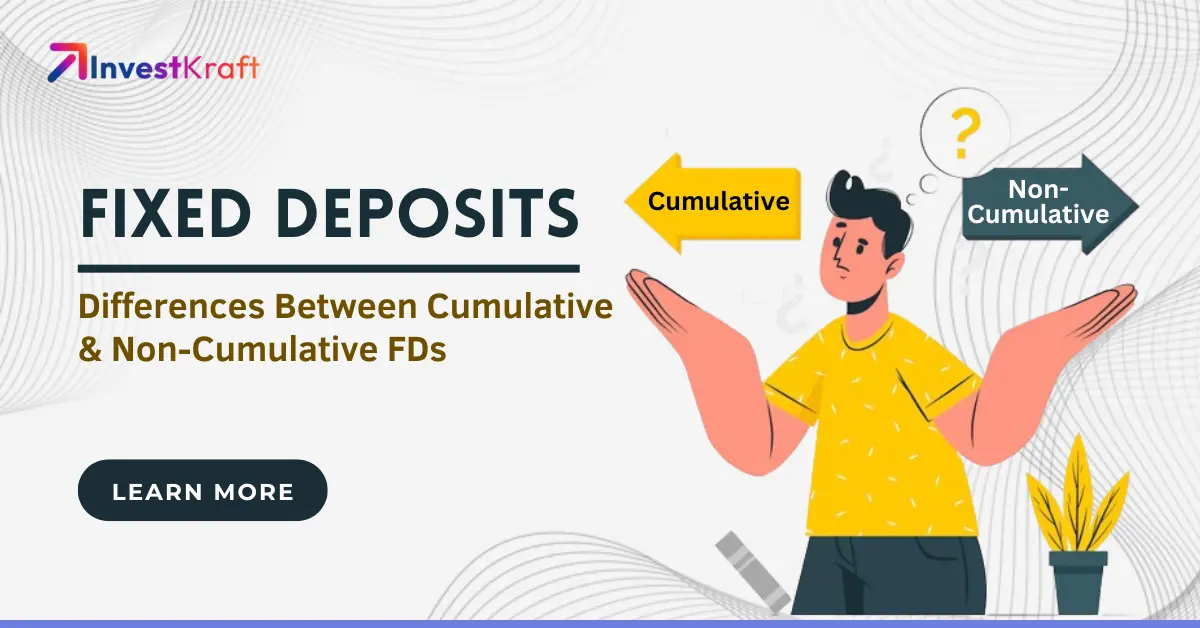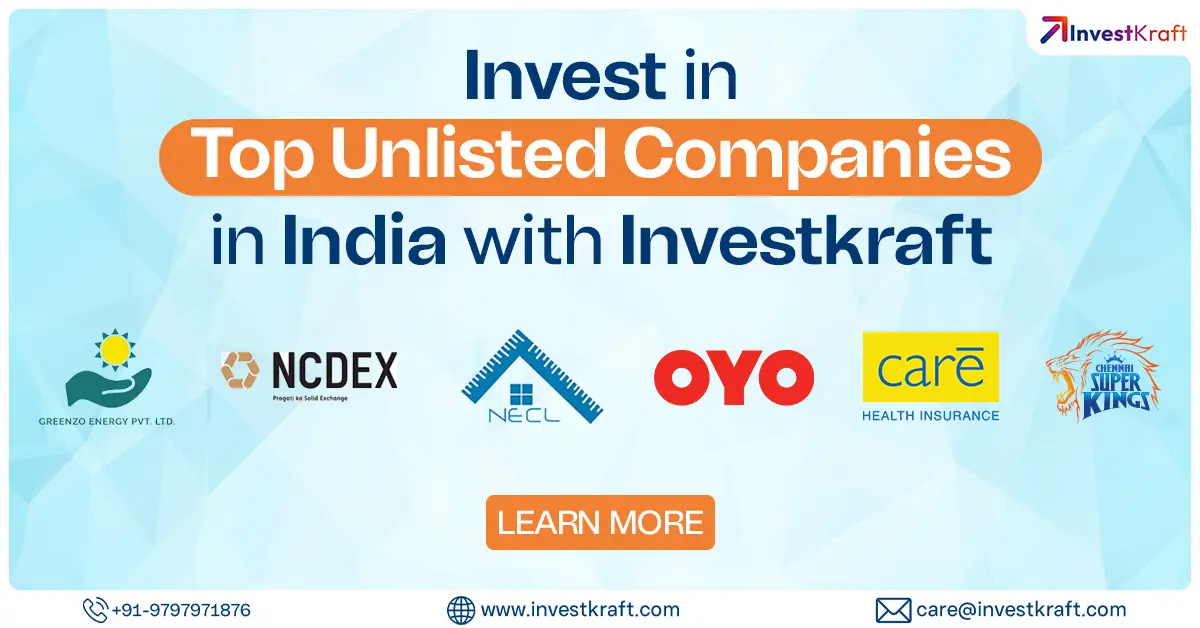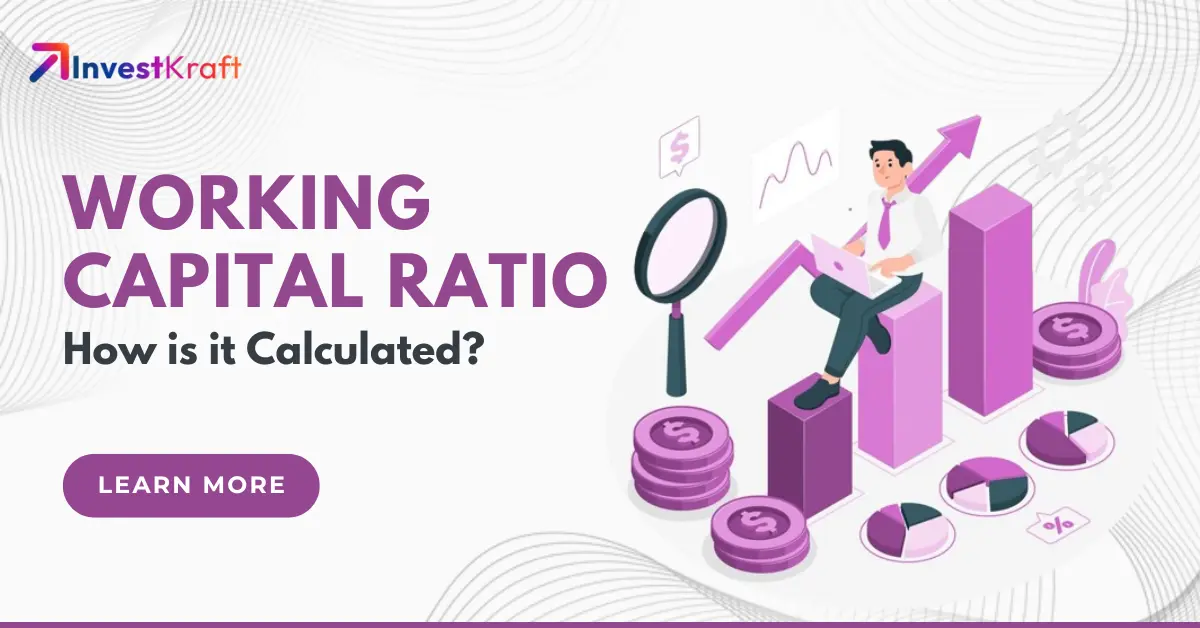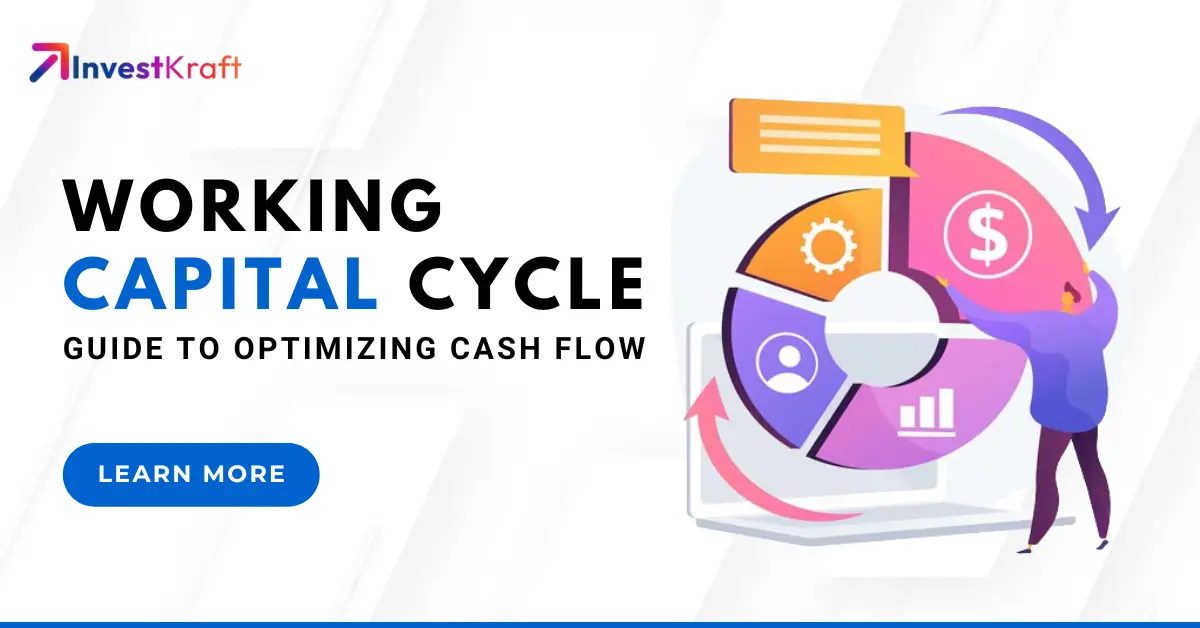Differences Between Cumulative and Non-Cumulative Fixed Deposits

A fixed deposit is a safe investment option in India that guarantees returns through interest. There are 2 types of fixed deposits -
- Cumulative fixed deposit
- Non-cumulative fixed deposit
In a cumulative fixed deposit, the interest is paid as a lump sum at maturity, while in a non-cumulative fixed deposit, the interest is regularly paid. This article will explain the differences between the two types of fixed deposits and help you choose the right one for your investment needs.
What is the Definition of a Fixed Deposit?
A fixed deposit is an investment scheme where you invest a lump sum amount for a specified time. In return, you receive interest as a reward. At the end of the period, the financial institution returns your principal investment amount along with the accrued interest.
Unlike other investments, fixed deposits offer guaranteed returns that are not influenced by market fluctuations. The interest earned on your deposit remains constant regardless of external factors. To determine your potential returns from a fixed deposit, you may utilize Investkraft’s online FD interest calculator.
Why Choosing the Right Type of FD Matters?
Banks and other financial institutions provide various fixed deposit options tailored to customers’ investment goals and budgets. These options vary in terms of limitations, benefits and features necessitating customers access to their requirements. By meticulously considering the available choices, customers can select the fixed deposit that aligns best with their priorities and objectives.
1. Cumulative Fixed Deposits (FDs)
The cumulative fixed deposit pays the interest accrued to the beneficiary when it matures. The interest is compounded either quarterly or annually. This means that the investor earns interest not only on the principal but also on the interest from previous periods. The compounded interest is added to the principal to determine the final maturity amount paid to the investor.
Cumulative FDs are ideal for individuals with stable business revenues or steady employment income, as they do not rely on interest earned for their financial needs. Additionally, those who are saving for a significant lump sum in the future and do not require regular interest payments may consider investing in cumulative fixed deposits.
How is Interest Accrued in Cumulative FDs?
Meet Priya, a diligent software engineer working in Bangalore. Priya has been saving a portion of her salary each month to build a substantial sum for her future. She decides to invest a portion of her savings in a cumulative fixed deposit scheme offered by a reputed Indian bank.
Priya opts for an FD with an initial principal amount of ₹500,000, a tenure of 5 years, and an annual compounding interest rate of 7%. With this information, Priya can calculate the maturity amount she'll receive at the end of the tenure.
Let's break down the calculation:
1. **Principal Amount (P)**: ₹500,000
2. **Annual Interest Rate (R)**: 7% (expressed as a decimal, 0.07)
3. **Tenure (n)**: 5 years
Using the formula for compound interest:
\[A = P \times \left(1 + \frac{R}{n}\right)^{n \times t}\]
Where:
- \(A\) is the maturity amount
- \(P\) is the principal amount
- \(R\) is the annual interest rate (as a decimal)
- \(n\) is the number of times the interest is compounded per year
- \(t\) is the number of years
For Priya's FD, the interest is compounded annually, so \(n = 1\). Plugging in the values:
\[A = 500,000 \times \left(1 + \frac{0.07}{1}\right)^{1 \times 5}\]
\[A = 500,000 \times (1.07)^5\]
Now, let's calculate:
\[A = 500,000 \times 1.402551415\]
\[A ≈ 701,275.70\]
So, at the end of the 5-year tenure, Priya will receive approximately ₹701,275.70 as the maturity amount. This amount includes both the principal and the compounded interest.
Cumulative FDs are beneficial for individuals like Priya who are looking to grow their savings steadily over time without needing regular interest payments. By opting for a cumulative FD, Priya can watch her money grow over the years and receive a significant lump sum at maturity, providing financial security for her future goals.
What are the Advantages of Investing in a Cumulative Fixed Deposit?
The advantages of investing in a cumulative fixed deposit are -
- It is an appealing choice for long-term investors due to the compounding effect, which results in higher returns upon maturity
- It is perfect for individuals who have long-term financial goals such as purchasing a house or planning for retirement
- Investors can rest easy as they do not have to concern themselves with periodic interest payouts since the interest is reinvested in the fixed deposit until maturity
2. Non-Cumulative Fixed Deposits (FDs)
A non-cumulative fixed deposit offers the choice of receiving interest payouts monthly, quarterly, half-yearly and annually. The payout frequency determines the regularity of receiving accrued interest. However, the amount paid out decreases over time to the fixed deposit’s predetermined return rate. It is important to note that the interest received is taxable as per the investor’s tax bracket.
The plan provides a range of maturity periods, from as short as 6 months to as long as 10 years. It is particularly suitable for investors, such as retirees, who desire a steady and reliable source of recurring income.
How is Interest Accrued in Non-Cumulative FDs?
Meet Mrs. Gupta, a retired school teacher living in Mumbai, India. After years of hard work, she has built up some savings and is now looking for a reliable investment option to generate a steady income during her retirement years.
Considering her financial goals and risk tolerance, Mrs Gupta decided to opt for a non-cumulative fixed deposit plan offered by a leading Indian bank. This plan allows her to choose the frequency of interest payouts – monthly, quarterly, half-yearly, or annually. She opts for quarterly payouts as it aligns well with her need for regular income to cover her expenses.
Mrs Gupta deposits Rs. 10,00,000 (ten lakhs) into the fixed deposit for a maturity period of 5 years, with an annual interest rate of 6.5%. According to the plan's terms, she will receive interest payouts every three months.
In the first quarter, Mrs. Gupta receives an interest payout of Rs. 16,250, which is calculated at the rate of 6.5% annually on her principal amount. However, she is aware that the interest payouts will decrease gradually over time due to the fixed deposit's predetermined return rate.
Over the next few years, Mrs Gupta will continue to receive quarterly interest payouts, albeit at decreasing amounts as the fixed deposit approaches maturity. These payouts provide her with a reliable and predictable source of income to meet her living expenses and enjoy her retirement comfortably.
At the end of the 5-year maturity period, Mrs Gupta receives the principal amount of Rs. 10,00,000 back, along with the final interest payout. She is satisfied with the returns generated by the fixed deposit, which not only provided her with regular income but also ensured the safety of her capital investment.
It is important to note that the interest received by Mrs Gupta is taxable as per her tax bracket. She consults with her financial advisor to understand the tax implications and plan her finances accordingly.
In conclusion, the non-cumulative fixed deposit plan proves to be an ideal investment option for Mrs Gupta, catering to her need for a steady and reliable source of recurring income during her retirement years in India.
What are the Advantages of Investing in Non-Cumulative Fixed Deposits?
The advantages of investing in a non-cumulative fixed deposit are:
- Non-cumulative fixed deposits offer a reliable income stream for investors, particularly those who depend on the fixed interest earnings to fulfil their financial requirements
- Investors have the flexibility to select the payout frequency based on their cash flow needs, allowing for better financial management. This feature enables investors to tailor their payout options to suit their circumstances and requirements, thereby enhancing the overall flexibility of the investment
How do I Decide Which Type of FD Suits My Financial Goals?
- Consider risk appetite when choosing a fixed deposit plan. For lower risk, go for shorter tenures to access the funds easily. For higher risk and possibly higher interest rates, choose longer tenures.
- Evaluate financial goals and liquidity. Short-term FDs offer better liquidity for immediate needs while long-term FDs suit retirement or major purchases.
- Compare interest rates offered by different financial institutions. Higher rates can impact investment growth. Research to find institutions offering competitive rates for your desired tenure.
- Choose credible and reputable financial institutions for a safe investment.
- Evaluate the flexibility of the FD scheme. Choose a scheme that aligns with your preferences and financial objectives.
Can I Switch Between Cumulative and Non-Cumulative FDs During the Tenure?
Yes, you can switch between cumulative and non-cumulative fixed deposits based on your financial requirements. Cumulative FDs accrue interest and pay out both the interest and principal at maturity, while non-cumulative FDs provide regular interest payouts at scheduled intervals. This flexibility allows you to align your investment strategy with your cash flow needs.
To switch between the FDs (cumulative & non-cumulative), you need to inform your bank about your preference. They will then offer options to convert your existing FD or open a new one based on your preferred payout frequency. Note that some banks might charge a nominal fee or add specific terms and conditions for this switch.
When switching FDs, remember to carefully review the terms and conditions, including interest rates, payout frequencies and any fees or penalties.
Consult a financial advisor for guidance to ensure your choice aligns with your financial strategy.
You may also like related posts;

Author: Abhik Das
Abhik Das is a versatile content writer with over 5 years of experience crafting engaging and informative content across diverse industries. His expertise spans the fields of ed-tech, pharmaceuticals, organic food, travel, sports, and finance.
Here's what sets Abhik apart:
Content Versatility: Able to adapt writing style and tone to suit various audiences and content needs.
SEO Proficiency: Creates content optimized for search engines, ensuring discoverability and organic traffic.
Deep Research: Conducts thorough research to ensure content accuracy and credibility across complex topics.
Engaging Storytelling: Captures reader interest with clear, concise, and compelling writing.
Abhik's diverse background empowers him to deliver insightful content across a wide range of subjects. Whether you're seeking engaging explainer pieces on the latest financial trends, informative guides to organic food choices, or captivating travelogues, Abhik has the expertise to craft content that resonates with your audience.

















